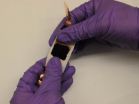(Press-News.org) Memo to casino operators: just because you build it doesn't mean they will come.
A new study out of the University of Iowa examined how casino growth in the state has influenced gambling by residents. The survey suggests that fewer Iowans gambled overall and also that fewer people have become addicted to gambling despite a recent spurt in gaming facilities. Casino gambling was introduced in Iowa in 1991. There are currently 21 casinos in Iowa, all but three licensed by the state. (The others are owned and operated by Native American tribes.)
The findings could affect expansion plans by casino operators and may influence how policymakers in Iowa, who must approve new casinos, view adding more gaming facilities, says Donald Black, a psychiatry professor at the UI who has been studying gamblers and gambling habits since the late 1990s.
"It seems society reaches a saturation point beyond which additional gambling opportunities won't capture more people," says Black, whose study was published in the journal Annals of Clinical Psychiatry. "And that applies to problem gamblers, too. They all seem to adjust to it."
The survey asked 356 residents in eastern Iowa 18 years of age and older about their gambling activity. The respondents were slotted according to the South Oaks Gambling Screen (SOGS), a known measure that ranks gambling behavior on a five-point scale, from no problems to addiction.
Black and his colleagues compared the results to similar surveys done in 1995 and 1989. The researchers report that the percentage of people who didn't gamble had risen to 83 percent in the most recent survey, versus 72 percent in the 1995 poll. Moreover, the percentage of non-gamblers in the latest survey was nearly as high as the 86 percent of Iowans who reported not gambling in the 1989 poll—before any casinos had been built in the state.
The prevalence of addicted gamblers, those with the highest ranking on the SOGS scale, also dropped in the most recent survey, from nearly 2 percent of respondents in the 1995 survey to 1.4 percent in the latest poll. This, despite a doubling in the number of casinos—from 10 in 1995 (including three racetracks that added slots that year) to 21 currently.
Still, the number of self-reported gambling addicts was far higher than the 0.1 percent who claimed a gambling addiction in 1989.
That suggests "casinos have had a great impact (on problem gamblers)," Black notes, "but it has stabilized."
Bolstering that notion, the percentage of residents who say they gamble occasionally (ranked 1 or 2 on the SOGS scale) had dropped to 14 percent in the latest survey from 23 percent in the 1995 survey.
Black adds that the results, although limited to Iowa, should hold true elsewhere. He said the findings substantiate a theory, championed by Howard Shaffer, a psychologist at Harvard Medical School, who looked at the impact of gambling in casino-rich Nevada and found that the number of people addicted to gambling was not disproportionately higher than other states.
Black likens the public's fascination with casinos as a child with a new toy. Sure, it's interesting at first, but at some point "it's lost its novelty," he says.
Gambling was legalized in Iowa in 1975 with the introduction of bingo. A state lottery followed in 1985, and dog and horse tracks were added in 1985 and 1989, respectively. Riverboat casinos were legalized in 1989, and the first three casinos, in Bettendorf, Dubuque, and Davenport, opened two years later. The state collected $116 million from casino gambling last fiscal year, according to the Iowa Racing and Gaming Commission.
The survey was conducted between 2006 and 2008 during a family study of problem gambling. The UI partnered with the Center for Social and Behavioral Research at the University of Northern Iowa on the poll.
INFORMATION:
Contributing authors from the UI include Jeff Allen, psychiatry professor; and Brett McCormick and Martha Shaw, psychiatry research associates. Authors from UNI include professors Mary Losch and Gene Lutz.
The National Institute on Drug Abuse (grant number: R01DA021361) and the National Center for Responsible Gaming funded the research.
More casinos does not mean more gamblers
2012-12-15
ELSE PRESS RELEASES FROM THIS DATE:
Doing the right thing when things go wrong
2012-12-15
ANN ARBOR, Mich. — The University of Michigan Health System doesn't claim to be perfect. But its response to medical errors, near-misses, unexpected clinical problems and unintended outcomes is a model for the nation that other hospitals can and should copy, according to a new paper in a prestigious health care journal.
The "Michigan Model" for handling these situations, and preventing them from happening again, has not only helped patients and medical staff alike – it has also helped UMHS go against the grain of the costly, combative "deny and defend" medical malpractice ...
Stretchable electronics
2012-12-15
Electronic devices become smaller, lighter, faster and more powerful with each passing year. Currently, however, electronics such as cell phones, tablets, laptops, etc., are rigid. But what if they could be made bendable or stretchy?
According to the University of Delaware's Bingqing Wei, stretchable electronics are the future of mobile electronics, leading giants such as IBM, Sony and Nokia to incorporate the technology into their products.
Beyond traditional electronics, potential stretchable applications include biomedical, wearable, portable and sensory devices, ...
Drug to treat opioid addiction poses risks for accidental exposure to children
2012-12-15
(SALT LAKE CITY)—Buprenorphine is a safe and effective drug for treating opioid addiction. But as the prescribed use of buprenorphine has dramatically increased in recent years, accidental exposure of children to the drug has risen sharply, placing them at risk for serious injury and in extremely rare cases even death, according to researchers at the Utah Poison Control Center (UPCC), U School of Medicine's Department of Family and Preventive Health, and the Utah Department of Health (UDOH).
In a study published Thursday, Dec. 13, 2012, by the U.S. Centers for Disease ...
NASA sees Tropical Cyclone Evan batter and drench Samoan Islands
2012-12-15
NASA's Tropical Rainfall Measuring Mission or TRMM satellite continues to provide rainfall and cloud height data on powerful Cyclone Evan as it crawls through the Samoan Islands with hurricane-force winds and heavy rains. NASA's TRMM satellite identified "hot towers" in the storm, hinting that it would continue to intensify.
On Dec. 14, American Samoa, Tonga and Fiji are all under warnings or alerts as Evan continues to move west. A gale warning is in effect for Tutuila and Aunuu. A high surf warning is in effect for all of American Samoa. A flash flood watch is in effect ...
In decision-making, it might be worth trusting your gut
2012-12-15
Turns out the trope is true: You should trust your gut -- as long as you're an expert. So says a new study from researchers at Rice University, George Mason University and Boston College.
"How expert someone is within a particular domain has a positive impact on their ability to make an accurate gut decision," said Rice's Erik Dane, lead author of a study published last month in the journal Organizational Behavior and Human Decision Processes. However, he added, "Even if you're an expert, intuitive decision-making is better for some types of tasks than others. Tasks that ...
Dreidel-like dislocations lead to remarkable properties
2012-12-15
HOUSTON – (Dec. 14, 2012) – A new material structure predicted at Rice University offers the tantalizing possibility of a signal path smaller than the nanowires for advanced electronics now under development at Rice and elsewhere.
Theoretical physicist Boris Yakobson and postdoctoral fellow Xiaolong Zou were investigating the atomic-scale properties of two-dimensional materials when they found to their surprise that a particular formation, a grain boundary in metal disulfides, creates a metallic – and therefore conducting – path only a fraction of a nanometer wide.
That's ...
We're all living longer, but longevity increases not benefitting everybody
2012-12-15
TORONTO, ON – Global lifespans have risen dramatically in the past 40 years, but the increased life expectancy is not benefitting everybody equally, say University of Toronto researchers. In particular, adult males from low- and middle-income countries are losing ground.
People are living longer on average than they were in 1970, and those extra years of life are being achieved at lower cost, the researchers, led by U of T Chemical Engineering PhD candidate Ryan Hum, say in a paper published in the open access science journal eLife this month.
However, the costs for ...
The HER2 paradox: HER2-positive stem cells found in HER2-negative breast cancer
2012-12-15
(SACRAMENTO, Calif.) — A multicenter study led by researchers at UC Davis describes new, paradoxical characteristics of the most common type of breast cancer. The findings shed light on how the disease can evade treatment and could improve diagnosis and treatment of breast cancer.
The research, led by Jian Jian Li, director of translational research in the UC Davis Department of Radiation Oncology, examined breast tumors previously thought to lack the HER2 protein, which, when over-expressed, is associated with disease recurrence. Instead, researchers found in the tumors ...
UCLA engineers develop new energy-efficient computer memory using magnetic materials
2012-12-15
By using electric voltage instead of a flowing electric current, researchers from UCLA's Henry Samueli School of Engineering and Applied Science have made major improvements to an ultra-fast, high-capacity class of computer memory known as magnetoresistive random access memory, or MRAM.
The UCLA team's improved memory, which they call MeRAM for magnetoelectric random access memory, has great potential to be used in future memory chips for almost all electronic applications, including smart-phones, tablets, computers and microprocessors, as well as for data storage, ...
A drug used to treat HIV might defuse deadly staph infections
2012-12-15
A new study by NYU School of Medicine researchers suggests that an existing HIV drug called maraviroc could be a potential therapy for Staphylococcus aureus, a notorious and deadly pathogen linked to hundreds of thousands of hospitalizations each year. Their study is published online this week in Nature.
"What are the chances that a drug for HIV could possibly treat a virulent Staph infection?" asks Victor J. Torres, PhD, assistant professor of microbiology, and senior author of the study. "These findings are the result of a fantastic collaboration that we hope will result ...



